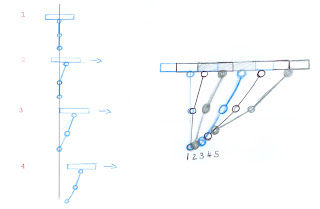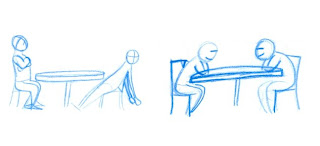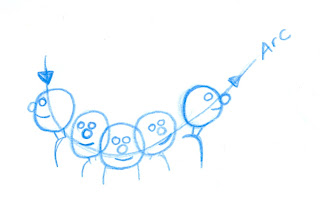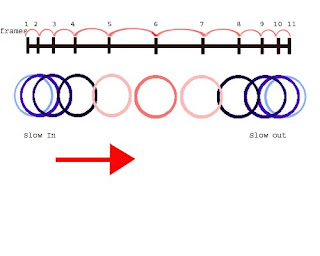Tuesday, 15 December 2009
Wednesday, 11 November 2009
Saturday, 24 October 2009
Wednesday, 16 September 2009
term 3 finished
Wednesday, 9 September 2009
Saturday, 29 August 2009
Mocap Vs Key Frame animation
1. My keyframed animation of a windmill dance move.
I used reference from you tube.
2.Here is the original mocap data before I fixed it.
3. The Motioncapture refined!
I would love to get sme feedback on this.
Thursday, 20 August 2009
NEW SHOWREEL Aug 2009
http://www.brendanfagan.com
It will be updated again, December, I've a few project on going, and will post once it's finished.
Wednesday, 12 August 2009
Tuesday, 28 July 2009
Sunday, 12 July 2009
Friday, 26 June 2009
Thoughts or emotions. Part 2

My repsonce to ED
I think what has distracted me, is that I believed that inner monologue is the same as thinking, and that's something we display on screen, usually with emotions expressed in the character, or a conflict, that our audience can empathize with. So I hope I get it now, and I think I do. Empathy is the key, like you say in your class.
Ed's repsonce was just brillent.
Note for today.
just don't say something with your pose choices. SAY IT!
Tuesday, 16 June 2009
Is it our characters thoughts or their emotions that drive their action in your scene.

PART 1
(I’m going to break this up as it’s a bit long)
Should our characters emotional expression be the driving force? Or should the character’s thoughts be the steam behind the engine.
Emotion 1st Thought 2nd Action 3rd
OR
Thoughts 1st Emotion 2nd Actions 3rd.
What drives our character's action? He or she wants something! How do they feel about it? And how do we show this on screen?
I wanted to share a conversation I had with Mr Ed Hooks on this matter.
I asked, was it our characters emotions or thoughts that should drive are scene? At first I thought it was a bit of both, which ultimately seems to be the answer.
“The connections between thinking, emotion and physical action are a little tricky……It is true that thinking can lead to action. I can decide that I want to take a sip of coffee from the cup next to my computer, and that physical action would not have much to do with emotion. It also would have no theatrical value. Professional wrestlers and boxers have quite a lot of physical action, and they train to remain level headed during a fight.
The most important thing to keep in mind is that we humans only empathize with emotion. We do not empathize with thinking. What you as an animator want to do is create in your audience a sense of empathy. So, although thinking CAN lead to physical action, what you are going for is emotion that leads to action.
Emotion all by itself has zero theatrical value. If you create a character that is so happy he is jumping up and down with glee, that is emotion leading to action, but it would lack conflict. If this was the first time he jumped up and down since the car wreck, he would have to contend with s stiff body and maybe weakened legs. That would make it theatrical.
Emotion and thinking is a two-way street. The way you feel affects the way you think. This is probably what people mean when they tell you that emotion leads to thinking that leads to action. There is NEVER a moment in our waking life when we are not experience some kind of emotion, even if only low-grade. As I write this, my emotions are not going off the scale, but I certainly have some. I am anticipating the arrival of some handymen who are going to fix some things in my home, so I am a little bit excited, and it causes me to type a little faster than I would normally. So, in this case, emotion affects my thinking, and my thinking leads to faster typing -- physical action. But there is very little conflict to my typing, so no audience is going to want to watch me do it for very long.
The way you think affects the way you feel. The way you feel affects the way you think. A person who is frightened might not make rational decisions. Still, the formula that thinking tends to lead to conclusions and emotion tends to lead to action is a valid one. What I want is for my students to understand that it is impossible to have emotions without thinking. Emotions are automatic value responses. Common sense dictates that you would not be afraid of an approaching rabid dog until you know it is a dog. Recognizing that it is a dog is a thinking process, not an emotional one.” Mr Hooks
There is great stuff in here, meaty subjects. I still had unanswered question on this topic which I will release shortly.
Note for today
“After all our studies, we aquire only that which we put into practice” -Goethe
(I’m not sure who Goethe is but I agree with him.)
Thursday, 11 June 2009
Animation Mentor

I'm heading back!!
I found it tricky to do some studying and animate at once at animation mentor on top off a full time job. You can do it, but I just didn't feel like I was getting enough out of it. By that I meen I don't think I was asking the right questions or enough questions. So I've spent the last 6 months or so studying hard and now ready to get back in. I fully recommend people to study the Illusion of life and also study Eric Larson notes and others that can be found at animationmeat.com. I also recommens Ed hooks books and as I've mentioned before Keith Lango has alot great video tutorials availble for download on his website. Study anything really you can get your hands on. There is so much out there. So Im ready to drive my mentors mental with questions.
my foot note for today.
Don't move anything without a reason.
Saturday, 6 June 2009
11 second Club June/ bombed
My biggest mistake was I played it too safe. I floated between poses and didn't hit them hard enough.
I need to hit my poses way harder than I think and I should hold my poses longer than I expect. It should improve my work.
I didn't emphasise my mouth shapes on F'W'O and G's in my lip sync.
I was recomended to use a webcam to record myself speaking the lines at a normal pace, then go back through and frame-by-frame through it to see how your mouth changes as it forms the words.
Hopefully with this advice, i'll improve.
The lipsync is a bit stiky on this. So please go to the link, to get proper playback.
http://www.11secondclub.com/competitions/may09/entry/vQ8Pes/
Friday, 22 May 2009
My degree film Suicidal paranoia
Degree film 2004-2005
Edinburgh College of Art.
I hope you enjoy it. At the time I was inspired by short films like Rejected and Happy Tree Friends.
Monday, 18 May 2009
Further notes on anticipation

If you treat anticipation like the blowing up off a balloon. The more air you put in it the bigger the bang you get. So If you have a long anticipating hold, followed by a fast violent/fast action. You will have managed to have work in some great contrast in your work.
I recently asked Keith Lango about anticipation as I was confused by one of his notes on a webpage I found long ago.
“Does the size of the anticipation match the speed of the subsequent action?”
Maybe it’s just me but at first I thought he meant. Does the anticipation equal the following move, are they the same length, which just didn’t sound right to me. So I asked him for further insight. My take on it now is that.
By saying match, He meant, does the anticipation relate to the follow up move. And by RELATE. It has many options. Slow followed by fast. Or slow followed by slow for comedic effect. Also if your going to take a step forward, there is a small (quickish) weight shift in your body in anticipation before you step forward.
Your anticipation depends on what effect you are looking for.
Keith followed up by saying
“The way I see anticipation, it's like blowing up a balloon. The bigger the bang you want, the more you blow it up. So the faster or violent move, the bigger the anticipation. The inverse is also true. The slow, more laid back the move, the less you need to build up and hold the anticipation energy. To step sideways there is a very slight anticipation in the opposite direction with the hips. This is not fast or severe or even held, but it exists. Then the step comes, usually at normal speed and without much fanfare. A more extreme version of this is the old WB off screen zip. Big antic, hold that antic a long time (let that energy really build up) and then explode off screen in 2 frames or less. You couldn't have a soft antic and then explode off screen in 2 frames or less. It'd feel all off. Now you probably could have a huge build up and held antic and then step off in a normal manner at normal speed- but the result would be extremely comedic. The comedy comes from setting up the expectation of a fast zoom, but then doing the unexpected with a normal step. That's probably the only instance of mixing and matching the antic/motion energies that works”
These notes are a great insight into anticipation. I just want to thank Mr Lango for clearing that up for me.
Monday, 11 May 2009
Important Questions to ask yourself about Acting in Animation
I've just started to look hard at acting in animation and heres a tip I picked up from Keith Lango. Again I fully recommentd him. He will raise your game.
1st What are the internal Realities for this character at this moment at this time and place?
(Ask yourself? What does this character need right now, what do they not have?)
2ndHow do they feel about it? What is their Emotional Reaction to it?
(Why can’t they have it?)
(Example: If you’re an attention seeker and nobody paying attention to you
= You want or need attention and you’re not getting it.
What are your emotional reactions?
= ANGER, FRUSTRATION, LONELY, UPSET, ETC.
Animation is: The outward expression of internal realties of our characters.
Thursday, 7 May 2009
The 12 basic Principles of animation.
Heres the principles and what they are for.
12 Basic Principles of Animation.
Squash and Stretch
Anticipation
Overlap and Follow through
Solid Drawing/ Solid Posing
Straight ahead and Pose to Pose
Staging
Arcs
Appeal
Slow in, Slow out
Secondary Animation
Timing
Exaggeration
1.Squash and Stretch
Squash can be the anticipation before and object moves. For example before you jump, you must go downward and in doing this you’re squashing your body down.
Stretch is when the weight of an object is left behind. So when you jump up, the earths gravity is pulling you down, therefore your body is being stretch.
The best example of Squash and stretch can be seen in a bouncing ball and it also the best exercise to help you get to grips with basic fundamental of animation principles.
2.Anticipation
Anticipation is when we are showing the audience what we are going to do before we do it. In order to take a step we shift our weight onto our standing foot, this is the body anticipating the movement. If you try to stand on one foot you will feel and see your body weight shift.
3.Overlap and Follow through
 An object in motion tends to stay in motion! Characters on the screen do not terminate suddenly. You need to animate your character coming to a natural rest, so that he remains alive on the screen. When you walk in a straight line and suddenly you stop yourself, you will notice that your body needs to catch up with itself. The legs stop but the torso neck head and arms will all overlap the movement until they come to a rest. Also you need to remember that there will be a successful braking of joints. Though out your body. Your waist will stop first, followed by your stomach (mid section) and then your chest, neck and head etc. Clothing items, hair and anything flexible on your character will overlap the characters movement also.
An object in motion tends to stay in motion! Characters on the screen do not terminate suddenly. You need to animate your character coming to a natural rest, so that he remains alive on the screen. When you walk in a straight line and suddenly you stop yourself, you will notice that your body needs to catch up with itself. The legs stop but the torso neck head and arms will all overlap the movement until they come to a rest. Also you need to remember that there will be a successful braking of joints. Though out your body. Your waist will stop first, followed by your stomach (mid section) and then your chest, neck and head etc. Clothing items, hair and anything flexible on your character will overlap the characters movement also.4.Solid posing
 You need to have a clear silhouette that displays the characters action, expressions and emotion. These poses must help the story telling of the scene. At least one pose in your scene should help tell the story. Solid drawing dose not mean you have to have a talent in shading and creating photographic interpretation. You need to draw quickly and clear in order to get your thumbnails down.
You need to have a clear silhouette that displays the characters action, expressions and emotion. These poses must help the story telling of the scene. At least one pose in your scene should help tell the story. Solid drawing dose not mean you have to have a talent in shading and creating photographic interpretation. You need to draw quickly and clear in order to get your thumbnails down.5. Straight a head and Pose to Pose.
This is the two different ways to animate. Straight a head method is when you do exactly that. Animate from frame 1 and continue until you stop. This type of animation can offer fluid results but lacks structure and can become time consuming.
Pose to Pose, is when you block in your scene with story telling poses, also know as golden poses. This will structure your scene and you won’t spiral out of control with this structure. Your poses should change when your character’s emotions change or when a character under takes a new action.
Remember this K.I.S.S = KEEP IT SIMPLE STUPID! Clarity and appeal are very important in your posing also!
6. Staging
 How you set up your scene to tell your story. Clarity and entertainment value are the important values of staging. Body gestures of people sitting together closely will represent two people who are interested in one another. Two people sitting with each other but looking and leaning away from each other will display discomfort between the two.
How you set up your scene to tell your story. Clarity and entertainment value are the important values of staging. Body gestures of people sitting together closely will represent two people who are interested in one another. Two people sitting with each other but looking and leaning away from each other will display discomfort between the two.7. Arcs
 Arcs make your movement more fluid. All movement in nature moves on an arc with maybe the exception of some insects.
Arcs make your movement more fluid. All movement in nature moves on an arc with maybe the exception of some insects.You need to track your arcs no matter if you’re working on computer or paper
8. Appeal
Appeal dose not mean cute and cuddly. Its means anything a person would like to see, is it interesting, funny, sad, etc?
Your poses are clear and the entertainment value is there. Your scene is clear and reads with the audience. You need to ask yourself would anyone other than your mother enjoy seeing this shot!! You have to be realistic about your work and push it as far as you can. Is it appealing enough for someone to pay to see it?
9. Slow in SLOOOW out
 When you move, your body builds up momentum and it takes time for that momentum to build up and also to stop. When your body is trying to stop moving it often will cushion that movements halt. When you start running the first step will not have the same speed as when you’re at full throttle. It will also take time for you to slow down. This also applies to subtitle movements, a slight twist of the neck will slowly move at the beginning of the movement and at the end of the movement. A characters movement can be slowed by adding more drawings into the scene.
When you move, your body builds up momentum and it takes time for that momentum to build up and also to stop. When your body is trying to stop moving it often will cushion that movements halt. When you start running the first step will not have the same speed as when you’re at full throttle. It will also take time for you to slow down. This also applies to subtitle movements, a slight twist of the neck will slowly move at the beginning of the movement and at the end of the movement. A characters movement can be slowed by adding more drawings into the scene.10. Timing
Timing is possibly the must important principle as its how you tell the story and sells the characters weight in his movement.
A heavy character will move slowly to sell his weight. And skinny guy will be moving faster as he has less weight to move around the screen. Timing will display emotion in character a slowly moving guy might be depressed or sick and a fast moving character will be up beat and excited about life.
Timing allows us to add texture and rhythm to the scene by having contrast in our movement. You want to have at least three speeds in your scene.
Slow medium and fast. You don’t want your scene to have a rhythm of
BEEP BEEP BEEP BEEP BEEP BEEEEEEP!
You want = Beep Booop bee boo bang twang bop be bo bo bop.
Treat your scene like a song, it needs to have rhythm.
11. Secondary Animation
A secondary motion by the character that helps carries the scene but does not take away from the main action. Fore example if a character is up set and turns his back to the screen, while the character is turning he wipes a tear from his eye. This movement would be classified as the secondary animation. It adds texture to the scene.
12. Exaggeration
Exaggeration is when we push are work that little bit further. Exaggerate the pose the timing to really sell are work. We are not duplicating reality but characterising it. We do this by pushing the characters emotion.
Wednesday, 6 May 2009
Morphing expression test
I've been trying to work in some realistic facial expression into my work. The test isn't perfect but its a step in the right direction. I modeled and animate this work.
I used reference from a great book called









